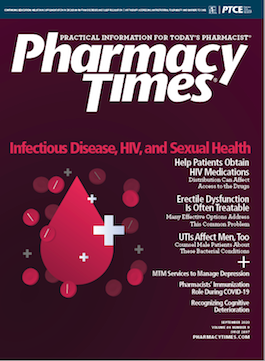Publication
Article
Pharmacy Times
Urinary Tract Infections Affect Men as Well as Women
Author(s):
Pharmacists can help male patients prevent, identify, and treat these bacterial conditions.
Urinary tract infections (utis) are thought of as a female issue and are, in fact, more common in women, but men get them, too.
Pharmacists can help male patients prevent UTIs, identify the symptoms, and treat these tricky conditions. Keep in mind that men who have UTIs may feel confused or embarrassed.
Let’s first look under the hood. UTIs occur because of bacterial growth in the urinary system through the urethra, which carries urine from the bladder to the tip of the penis. The reason that women are more susceptible to UTIs is the female urethra is shorter than the male urethra. On average, the female urethra is just 4 cm long compared with the male urethra, which is generally 20 cm long.1 As men have longer urethras than women, they are less prone to UTIs because bacteria need to travel a longer distance to reach the bladder.
Most UTIs are caused by a bacteria called Escherichia coli (E coli).2
Normally, E coli is present in the intestines of ani- mals and people and can play an important role in a healthy human gastrointestinal tract.3 However, E coli in the urethra can cause an infection.
Common signs and symptoms of a UTI include chills or rigors, a fever, malaise, and significant fatigue. In addition, UTIs may cause a constant urge to urinate, increased or painful urination, or the presence of pus in the urine. Other symptoms can include costovertebral angle tenderness, flank pain, and pelvic or perineal pain.2,4
A UTI can be mistaken for a common cold or the flu because the signs and symptoms are often similar. A urine test can help detect a UTI or help find another cause of the condition.5 In addition, a physical examination will help assess the cause of pain around the urinary tract area.4
It is important for patients to seek immediate help, because the possible complications of an untreated UTI may lead to acute renal failure, organ system abnormalities, sepsis, and shock.2
The causes of UTIs include being older, diabetes, not being circumcised, sexual intercourse, and a urinary tract obstruction.4,6 Also, incomplete emptying of the bladder can put patients at risk for UTIs, although this can be caused by prostate growth or a recent urinary tract procedure involving instrumentation, such as insertion of a tube to drain the bladder (catheterization) in men.4
After receiving a UTI diagnosis, patients will be treated with antimicrobial medications and will begin therapy based on pathogens found in the urine test, individual factors, and other considerations.5
Here are some common medications prescribed, along with some key counseling points:
• Oral ciprofloxacin or levofloxacin for 5 to 7 days. Advise patients to take this medication at the same time each day, with a full glass of water and with or without food. Avoid antacids and foods that contain dairy or are rich in calcium for at least 2 hours before or 2 hours after, in the case of ciprofloxacin. Inform patients that upset stomach or diarrhea are common and self-limiting. They need to reach out to their doctor immediately if noticing any tendonitis, muscle weakness, peripheral neuropathy, and central nervous system effects.7,8
• Oral trimethoprim/sulfamethoxazole for 7 to 10 days. Advise patients to take this at the same time each day, with a full glass of water and with or without food. Let them know that diarrhea or an upset stomach are common and self-limiting.9
• Oral amoxicillin-clavulanate for 10 to 14 days. Advise patients to take this with food, and let them know that diarrhea is the most common adverse event (AE).10
• Intramuscular or intravenous ceftriaxone or ertapenem. The most common AEs for ceftri- axone are induration, skin tightness, and a warm sensation at the injection site. The most common AEs for ertapenem are diarrhea, nausea, and vomiting.11,12
• Intramuscular or intravenous gentamycin or tobramycin. Advise patients that there may be injection site pain. Monitor patients for hearing, kidney, and nerve problems.13,14
In terms of preventing UTIs, some tips include increasing fluid intake, urinating frequently, and frequent handwashing with hot water and antibacterial soap.4
References
- Carpenter R, Müller F, O’Rahilly R, Swenson R. The ureter, bladder and urethra. In: Swenson R, ed. Basic Human Anatomy. W.B. Saunders; 2008.
- Hooton TM, Gupta K. Acute complicated urinary tract infection (including pyelonephritis) in adults. UptoDate website. Updated August 21, 2019. Accessed January 27, 2020.https://www.uptodate.com/contents/acute-complicated-urinary-tract-infection-including-pyelonephritis-in-adults
- CDC. E. coli (Escherichia coli). Centers for Disease Control and Prevention Website. Updated December 1, 2014. Accessed February 10, 2020. https://www.cdc.gov/ecoli/general/index.html
- Hooton T, Calderwood S, Bloom A. Acute simple cystitis in men. UptoDate website. Updated July 27, 2018. Accessed February 10, 2020. https://www.uptodate.com/contents/acute-simple-cystitis-in-men
- Gupta K, Hooton TM, Naber KG, et al. International clinical practice guidelines for the treatment of acute uncomplicated cystitis and pyelonephritis in women: a 2010 update by the Infectious Diseases Society of America and the European Society for Microbiology and Infectious Diseases. Clin Infect Dis. 2011;52(5):e103-120. doi: 10.1093/cid/ciq257
- CDC. FAQs: urinary tract infection (UTI) events. Centers for Disease Control and Prevention website. Updated April 14, 2020. Accessed February 2, 2020. https://www.cdc.gov/nhsn/faqs/faq-uti.html
- Ciprofloxacin. Drugs.com website. Accessed May 8, 2020. https://www.drugs.com/ciprofloxacin.html
- Levofloxacin (systemic). Drugs.com website. Accessed May 8, 2020. https://www.drugs.com/ppa/levofloxacin-systemic.html
- Trimethoprim-sulfamethoxazole: an overview. UptoDate.com website. Accessed May 8, 2020. https://www.uptodate.com/contents/trimethoprim-sulfamethoxazole-an-overview
- Amoxicillin and clavulanate. Drugs.com website. Accessed May 8, 2020. https://www.drugs.com/amoxicillin_clavulanate.html
- Ertrapenem. Drugs.com website. Accessed May 8, 2020. https://www.drugs.com/mtm/ertapenem.html
- Ceftriaxone. Drugs.com website. Accessed May 8, 2020. https://www.drugs.com/mtm/ceftriaxone-injection.html
- Tobramycin. Drugs.com website. Accessed May 8, 2020. https://www.drugs.com/international/tobramycin.html
- Gentamicin (systemic). Drugs.com website. Accessed May 8, 2020.







